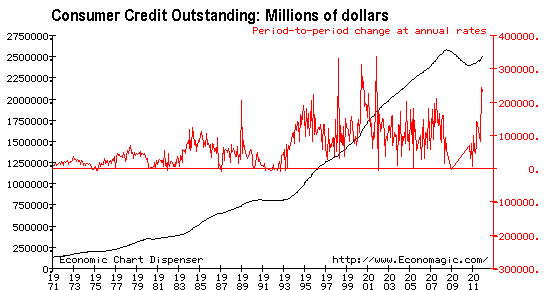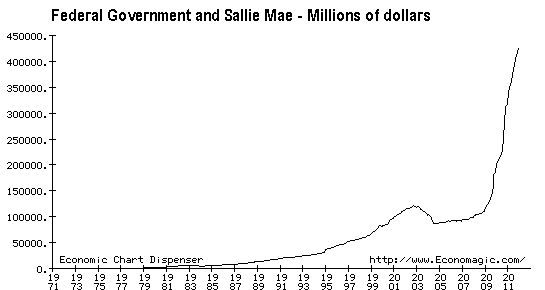

My Two Cents - "Lagging Indicators and Nagging Fundamentals"
02/10/2012
After the first weekend of the Holiday shopping season, there were jubilant members of the mainstream press virtually jumping out of their skins at the news that holiday spending was looking strong. The initial counts showed an uptick in spending and that was all the MSM needed. Interestingly at the same time, the ‘bad cops’, namely the Fed and other central banks, were quietly talking about more easing, the rotten labor market, and the debt crisis in Europe, still bubbling beneath the surface. So what gives here? Is the economy back off to the races or are we merely continuing to kick the can down the road in spite of the obviously sour fundamentals?
Christmas Credit Binge
One of the biggest questions asked during the course of the holiday shopping season was where the money came from. Every month, BLS releases statistical reports that show that more and more people are leaving the labor force, the unemployment rate remains high, and the number of marginally attached workers is not shrinking considerably. Translating this to English, the labor market has been relatively stagnant. On another front, home prices have continued to fall in most major markets. Personal incomes have not appreciated significantly, yet there seemed to be plenty of money for excess holiday spending.
On February 7, 2012 we finally got the beginnings of some answers. Consumer credit increased $19.3 Billion, the majority coming from auto and student loans. Mainline economist automatically came out saying that the willingness of consumers to take on more debt is indicative of positive expectations of the economy. One of these ‘economists’ also went as far as to say that since 2008, consumers have done a ‘very good job of repairing their balance sheets’. While this may have been true from the last quarter of 2008 through the beginning of 2010, the repair phase is over; at least where consumer credit is concerned. The swipe until you drop phase appears to be back in full swing.
Revolving debt, which includes credit cards, increased by a whopping $2.76 Billion in December. Fourth quarter profit at MasterCard increased by 24% and the company’s stock surged 66% in 2011, ranking #4 in the entire S&P500 in terms of price performance. There was one minor encouraging sign in these otherwise awful numbers; debit card purchases increased by 18% while credit card purchases increased by just 6%. In absolute dollars, credit card spending far outstrips that of debit cards, but a swing towards debit cards means at least a portion of the population is starting to get tired of getting jabbed for 15% (or more) by their banks for credit card purchases while getting less than 1% for keeping their savings at those same banks. Bravo to those who have had enough of the ‘making payments’ mentality!

Unfortunately, this is a sword that cuts both ways no matter how one chooses to look at it. On one hand, the accumulating of additional debt can be viewed as positive since consumers believe that the economy is on the mend and they don’t mind taking the additional risks. The flip side is that consumers are willing to do whatever it takes to attain/maintain a standard of living and don’t mind piling up debt to accomplish this fact. Of particular concern is the student loan portion of the debt numbers. College kids are borrowing veritable fortunes to finance their schooling and as many statistical surveys have shown over the past couple of years, the payoffs just aren’t there. This is certainly not a generalization because there are some very hot fields right now, but there are many, many others that are as frigid as the North Pole.
There is a third possibility in here regarding debt too and it is the most frightening. Unfortunately, the numbers won’t show it, but how much of this increase in credit spending is not for convenience or foolish spending, but being done as a last resort? In a country where tent cities are largely ignored by the press, and food stamp usage continues to increase every month, it also stands to reason that there are people who are accumulating additional credit card debt simply because they have no choice.
Perhaps the most ridiculous statement made in any of the mainstream pieces on this topic was that credit was likely to continue to expand along with demand. This was said in a very matter of fact tone. Let’s think about what this means for a minute. It means that the only reason demand is increasing at all is because it is being monetized. Either by various government programs, or worse: by credit. This is nothing more than a tacit admission that our economy is hooked on credit. What’s the surprise? We’ve known that for years now. The twist in all of this is the fact that the accumulation of debt, once having had the shame removed from it, has now been mainstreamed. It is cool to be in debt. It is cool to make $40K/year, spend $60K and pay $50/month for the privilege of living beyond your means. The joke must be on us, right?
The College Loan Bubble
Such is not the case with the student loans though. The payments are much higher than $50/month and the balances are enough to make a good accountant go cross-eyed. Ironically, since the government essentially nationalized the student loans industry (for the good of students we were told), borrowing to go to college has absolutely taken off. Is there even one person reading this article to thinks that there is no connection between the availability of student loans and the runaway costs? Perhaps I might point those same people to the situation with housing and what happened once the government started essentially guaranteeing housing loans. The price of a home went sky high and affordability went way down. The same is now happening with college.

American Idle
Sadly, the prospects for college graduates these days (again, not a generalization) are about as good as those for folks who bought homes in 2005 and 2006 expecting to ‘Retire on the House’ as one rather obscene book was entitled. Let’s just take a look at some of the employment numbers from the last few months. We’ve seen discouraged workers leaving the workforce in droves. 1.2 million of them in January to be exact. Now let’s make sure we properly characterize these folks. They do not have jobs. They don’t have job prospects, and are discouraged to the point where they’ve stopped looking. Once this is the case for 12 months, they no longer count. They are not part of the workforce, and as such as not counted among the ranks of the unemployed. But wait. These people don’t have jobs? Nope. They aren’t collecting unemployment? No they aren’t. But the government just lets them fall out of the statistics? Absolutely.
There is no doubt that the ‘population’ adjustments, etc. will take time to work their way through the numbers. There are a couple of things that are particularly curious about January’s report. Obviously the biggest is the shrinkage of the workforce and concomitant decrease in the ‘headline’ unemployment number (now at 8.3%), but what is extremely disconcerting here is that the birth/death model was not responsible for adding most of the 243K jobs that BLS says were added to the economy, it was responsible for removing 367K additional jobs. Pundits could have run away with that one, saying that there were really nearly 600K jobs added in January save for the ramblings of a computer model, but what the model is saying is that businesses are dying much faster than they’re being created and this is resulting in the loss of jobs. The food for thought nugget here is pretty simple. We certainly have had plenty of reasons to doubt the accuracy of the model when it was adding jobs that nobody could seem to find. What now to make of the fact that it is removing jobs, implying that business deaths are outpacing births? This is not a one-off event either. 4 of the past 5 reporting months have demonstrated this phenomenon, although never to this extent. Obviously, BLS made some population adjustments, which could be responsible for the huge swing, but if nothing else, it gives us just one more reason to be skeptical of government ‘data’, especially when it involves politically sensitive areas during an election cycle.
Conclusions
There are some concrete conclusions that may be drawn from the realities detailed above. First, the accumulation of debt should never be confused with economic strength. Borrowing is a reversible transaction, meaning that the money borrowed must be repaid at interest. This is the case whether is MasterCard, a municipal bond or a US Treasury note. Sure, the act of borrowing puts money in your pocket and might make you feel ‘rich’ for a time, but that feeling is fleeting as many nations are finding out. There is not one single instance in all of human history of a nation borrowing its way to prosperity although I am told the folks at the History Channel are working hard to revise the fate of the Roman Empire.
Secondly, it only makes sense to accumulate the debt necessary to obtain a decent baccalaureate degree only if there are good odds that employment can be found to repay the debt and leave the borrower with a desirable standard of living afterwards. After all, college is an investment, not a birthright, and we seem to have confused the two in America. If you ran a burger joint, you might consider adding another wing onto your restaurant, but you’d only do so if you were reasonably sure that doing so would bring in enough additional patrons to pay for the expansion and leave the business better off in the long run. College should be a similar decision. Students who have ‘no idea’ what they want to major in might spent a year or two at a community college until they can figure it out. Some kids might opt to skip college entirely to go to a trade school. Not having a college education has become such a stigma in this country and we have forgotten our roots. We have forgotten our history. Was it Harvard MBAs who powered the industrial revolution or guys (and girls) who knew how to work hard and didn’t mind getting their hands dirty? Today nobody wants to get their hands dirty. We’d rather import it from China and run ourselves into debt so we can run off and study sociology at some upscale liberal arts college.
The 2012 election cycle needs to be about these types of issues, not the pabulum and tripe that has passed for ‘debate’ thus far. We need leaders who are willing to roll up their sleeves and actually get their hands dirty instead of outsourcing our precious jobs, and then borrowing money so we can buy goods imported from the same places we sent our jobs. Really, does this sound sustainable to you?
Until Next Time,
Graham Mehl is a pseudonym. He is not an ‘insider’. He is required to use a pseudonym by the policies of his firm when releasing written work for public consumption. Although not an insider, he is astonishingly bright, having received an MBA with highest honors from the Wharton Business School at the University of Pennsylvania. He has also worked as an analyst for hedge funds and one G7 level central bank.
Andy Sutton is a research and freelance Economist. He received international honors for his work in economics at the graduate level and currently teaches high school business. Among his current research work is identifying the line in the sand where economies crumble due to extraneous debt through the use of economic modelling. His focus is also educating young people about the science of Economics using an evidence-based approach.